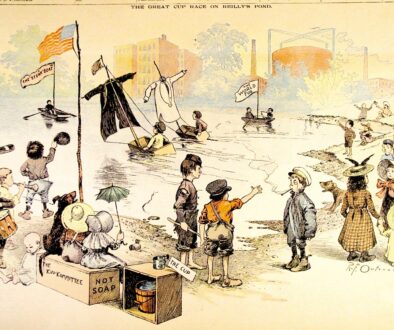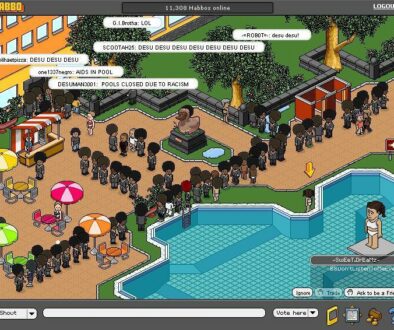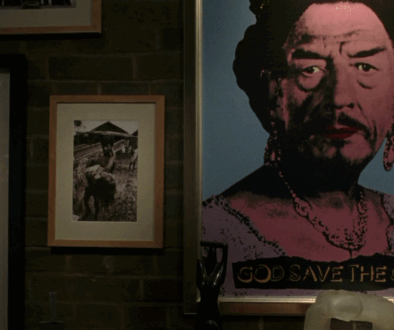By His Torment, The World Was Redeemed (The Last War in Albion Part 59: Down Among the Dead Men, Pogo)
This is the ninth of twenty-two parts of Chapter Eight of The Last War in Albion, focusing on Alan Moore’s run on Swamp Thing. An omnibus of all twenty-two parts can be purchased at Smashwords. If you purchased serialization via the Kickstarter, check your Kickstarter messages for a free download code.
The stories discussed in this chapter are currently available in six volumes. The first volume is available in the US here, and the UK here. The second is available in the US here and the UK here. Finding volume 3-6 are, for now, left as an exercise for the reader, although I will update these links as the narrative gets to those issues.
 |
| Figure 435: Swamp Thing and Arcane meet again in hell. (Written by Alan Moore, art by Steve Bissette and John Totleben, from Swamp Thing Annual #2, 1984) |
 |
| Figure 436: A characteristically dynamic page layout from Neal Adams’s early career work on Deadman. (Written by Carmine Infantino and Jack Miller, from Strange Adventures #207, 1967) |
the series would end (since Deadman’s unlife explicitly lasts until he finds his murderer). But as with the
 |
| Figure 437: The first appearance of the Phantom Stranger. |
original run of Wein/Wrightson Swamp Thing tales, there is much to like in the original run of stories.
 |
| Figure 438: In one four possible origin stories, the angel that became the Phantom Stranger has his wings torn off. (Written by Alan Moore, art by Joe Orlando, from Secret Origins #10, 1986) |
Moore, when writing the character, tended to imply that he had some Biblical origin, and indeed in 1987 wrote one of four possible origin stories for the character in Secret Origins #10, alongside Dan Mishkin, Paul Levitz, and Mike Barr. Moore’s story is structured as two parallel stories, told on alternating pages, that cover essentially the same ground on different scales. The first is the story of a member of New York’s red-beret wearing Subway Angels, a volunteer organization founded in 1979 to patrol the increasingly dangerous New York Subway, while the second is a set around the fall of Lucifer. In both, the protagonist is torn between two rival factions, fails to commit to either, and is brutally rejected by both as a result. The stories converge in the final two pages as the Phantom Stranger appears to him after he has been beaten and helps him up, giving a solemn speech about how, “lonely inside our separate skins, we cannot know each other’s pain and must bear our own in solitude. For my part,” he explains, “I have found that walking sooths it; and that, given luck, we find one to walk beside us… at least for a little way.”
 |
| Figure 439: The staggering scale of the Spectre is revealed to Swamp Thing and the Phantom Stranger (Written by Alan Moore, art by Steve Bissette and John Totleben, from Swamp Thing Annual #2, 1984) |
Finally, Moore introduces the Spectre, a Golden Age hero who served as God’s vengeance, best known for a run of ten issues in the mid-70s written by Joe Orlando and Michael Fleisher, with art by Jim Aparo, which vented Orlando’s frustrations and anxieties after being mugged, with the Spectre meting out gruesome punishments to criminals that skirted the edge of what was permissible under the Comic Code of the time. It is not that any of these characters are particularly obscure, although none had been in particularly active use prior to “Down Among the Dead Men,” with the Phantom Stranger, who had previously had a backing feature in Saga of the Swamp Thing during Pasko’s run, being the closest thing to a regularly appearing character. What the characters were, however, were ones who (along with Swamp Thing himself) would have featured in the comics of Moore’s childhood and adolescence. All of the characters had prominent runs in the late 60s/early 70s that Moore would have been the perfect age for, and that stood out distinctively in the era. They are certainly not the only characters Moore loved, but they nevertheless have ties to a common moment that Moore was both celebrating and updating for the present day. Which was in many ways the point of the exercise. “Down Among the Dead Men” is in no way a complete collection of DC’s mystical and supernatural characters, but it is a thorough enough one, and Moore, by lashing them together into a single story, makes a tacit demonstration that his by now clearly successful approach to writing Swamp Thing was not some fluke, but rather a viable approach to a particular sort of comic in general. And it is telling that “Down Among the Dead Men” roughly coincided with the point where Moore began to get other work at DC.
 |
| Figure 440: Although best known as a newspaper strip, Pogo made his first appearance in Dell’s Animal Comics #1. |
Pogo was a newspaper strip written and drawn by Walt Kelly, featuring the characters of Pogo the Possum and Albert the Alligator, initially created in 1941 for Dell Comics’ Animal Comics, but made more famous as an editorial page comic in the New York Star and, starting in 1949, as a nationally syndicated comic. The strip is in the grand tradition of American “funny animal” comics and cartoons that accompanied and, gradually, replaced minstrelsy’s role in American comedy. Pogo is an everyman sort of possum living in the Okefenokee Swamp on the Georgia/Florida border along with a menagerie of absurd friends and companions, of which Albert is the most prominent. The comic’s strengths are severalfold. For one, Kelly is a gifted cartoonist whose figures are reliably both expressive and ridiculous. For another, Kelly’s command of language was exquisite in a way few, if any of his contemporaries (or indeed imitators) could match. His characters speak in an invented vernacular long on misspellings and malapropisms, proclaiming things like, “us must git our e-quipments quipped up afore the expedition pedooshes,” and an annual tradition of fractured Christmas carols, the most famous of which began, “Deck us all with Boston Charlie / Walla Walla, Wash., an’ Kalamazoo! / Nora’s freezing on the trolly / Swaller dollar cauliflower alley-garoo!”
 |
| Figure 441: Simple J Malarkey, a parody of Joseph McCarthy, in a 1953 Pogo strip by Walt Kelly. |
Kelly turned these strengths to effective satire, skewering the establishment of American politics in most every direction, most famously in his character “Simple J. Malarkey,” a caricature of anti-Communist crusader Senator Joseph McCarthy. When, in a typically Kellyesque series of events, The Providence Bulletin declared that it would drop the strip if Malarkey appeared again, Kelly responded by simply having the character appear with a paper bag over his head. This was only the most famous of many times Kelly found himself in trouble with the papers distributing his strip, and eventually he settled on the tactic of creating a second set of strips whenever he was doing something controversial. These strips would feature many of the same political points, but in a toned down and subtler manner often featuring cute rabbits as the characters. Kelly, for his part, was open about the practice, making it clear that if readers saw Pogo strips featuring cute bunnies then their newspapers were engaging in censorship.
 |
| Figure 442: Arguably the most famous Pogo strip was Kelly’s poster for the 1971 Earth Day. |
But for all that Pogo was overtly and satirically political, it was also appreciably broad in its targets. Kelly liked to claim that he was opposed to “the extreme Right, the extreme Left, and the extreme Middle,” and Kelly’s satire, even when it took aim at specific figures, tended to mainly suggest that everyone was in the same absurd and slowly sinking ship, and that the problem with the world was the people in it. This is best exemplified by the most famous quote to come out of the comic, the punchline to a poster Kelly, a committed environmentalist, created for one of the earliest celebrations of Earth Day. The strip features Pogo and another character walking across the swamp, then pulls back to show the mass of litter and junk that they’ve been walking across, as Pogo glumly comments that “we have met the enemy, and he is us.”
 |
| Figure 443: Pog explains his history to Swamp Thing by drawing pictures on the ground. (Written by Alan Moore, art by Shawn McManus, from Swamp Thing #32, 1984) |
Moore’s Pogo homage, fittingly, returns to the ecological themes that characterized his earliest issues of Swamp Thing, and that would come to characterize his best work on the title. The story features a ship of aliens drawn by McManus in a cartoonish and Kelly-esque style, and given a wordplay heavy way of speaking that similarly evokes Kelly’s work. “Don’t be unmembered to tell the Tadling see if old Strigiforme is fetchable nowabouts,” Pog, the leader of the aliens says at one point, before breaking off to marvel at the swamp in which they have landed, saying, “A new Lady! A new Lady as envirginomental as the old one!” Eventually the aliens encounter Swamp Thing (who, in this issue, speaks only in an incomprehensible string of symbols), and explain to him their origin, telling him how on their planet (which they call the Lady) “there was one solitribal breed of misanthropomorphs who refused to convivicate with elsefolk. They constructed their own uncivilization, and exclucified anykind else from joining it. They were the loneliest animals of all. They took our lady away from us.” He goes on to explain the horrible things these animals did, running medical experiments and, worse, killing and eating the other creatures until Pog and his shipmates set forth in their ship Find-the-Lady to find a new Lady on which to live, which Pog believes that they have now done.





August 29, 2014 @ 2:49 am
see if old strigiforme is fetchable nowabouts
Actually, in-story, Strigiforme is a proper name.
and excluded anykind else from joining it.
Again actually, Shipboss Pog uses the compound "exclucified".
August 29, 2014 @ 4:21 am
a goddess named Rama Kushnu
Rama Kushna.
August 29, 2014 @ 4:32 am
a bastardization of the real goddess Rama-Krishna
Not sure what you mean here. Rama and Krishna are male avatars of the male god Vishnu.
August 29, 2014 @ 5:01 am
The beginning of this sentence is missing: "…that he had some Biblical origin, and indeed in 1987 wrote one of four possible origin stories for the character in Secret Origins #10, alongside Dan Mishkin, Paul Levitz, and Mike Barr."
August 29, 2014 @ 5:04 am
It's worth noting that the effect of putting a bag on Simple J. Malarkey's head was to make him look like a Klansman.
August 29, 2014 @ 7:48 am
Ah! So it's a paper bag, not a paperback! That makes more sense…
August 29, 2014 @ 8:42 am
Walt Kelly is my all-time favorite comic creator; and Pog is my all-time favorite Alan Moore comic. The more you know about Kelly's work, the funnier and more touching Moore & McManus's tribute becomes.
Just to mention a couple favorite details: The primary turtle character in Pogo was Churchy LaFemme; so calling the ship "Find the Lady" isn't much of a stretch at all. And Phil mentions "Deck us all with Boston Charlie", which appears late in the story in an even more fractured- and heartbreaking- form.
Anybody interested in seeing some of the very early Pogo material can look here; the copyright on the actual Pogo comics was correctly renewed but Kelly missed the anthology stories:
http://digitalcomicmuseum.com/index.php?cid=571
Be warned: These are very early stories; and while fascinating and charming are not as good as the later material. And while Kelly is rightly praised for what is probably the best characterization of African-Americans in the Golden Age of comics (his development of Bucky in Our Gang), he didn't necessarily start out that way. Bumbazine and others can be a little rough on modern sensibilities.
August 29, 2014 @ 8:49 am
It's also worth noting that Malarkey put the bag on when Miss Sis Boombah, a Rhode Island Red, shows up. The paper specifically said they would drop the strip if the character showed his face again.
To the paper's credit, they did NOT drop the strip; they just moved it to the editorial page.
August 29, 2014 @ 9:05 am
Walt Kelly is my all-time favorite comic creator
Mine too. Maybe after this series, Phil can write The Last War in Faux Dixie, feature a vast spiritual battle between Kelly and Al Capp.
August 29, 2014 @ 9:34 am
This and several other errors are now fixed.
August 29, 2014 @ 12:53 pm
You didn't fix the "goddesses" one.
August 29, 2014 @ 10:24 pm
a bastardization of the real gods Rama and Krishna
So we now know Phil is a Hindu.
August 29, 2014 @ 10:41 pm
I should think that the phrase "real gods" in close proximity to a discussion of Alan Moore ought not necessarily be taken in its most straightforward context.
August 30, 2014 @ 7:16 am
"Ancient cultures did not worship idols. Their god-statues represented ideal states which, when meditated constantly upon, one might aspire to. Science proves there never was a mermaid, blue-skinned Krishna or a virgin birth in physical reality. Yet thought is real, and the domain of thought is the one place where gods inarguably exist, wielding tremendous power. If Aphrodite were a myth and Love only a concept, then would that negate the crimes and kindnesses and songs done in Love's name? If Christ were only ever fiction, a divine Idea, would this invalidate the social change inspired by that idea, make holy wars less terrible, or human betterment less real, less sacred?" –Alan Moore, What is Reality?
February 18, 2015 @ 11:48 pm
"Figure 435: Swamp Thing and Arcane meet again in hell."
This was an ever so slightly disturbing sequence (though I loved it) for me as a teen, as somehow the subtlety conveyed both the feeling and the sound of insects hatching inside Arcane (yuck!)
Pog, oh my I adored utterly the Pog story. Never read any of Walt Kelly's work before and hadn't even heard of him at the time. So this little gem of weird was such a surprise. It's one of the highlights of Moore's run on Swamp Thing (though for me it's all a highlight!)